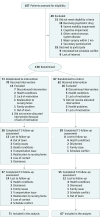Effects of Mindfulness Yoga vs Stretching and Resistance Training Exercises on Anxiety and Depression for People With Parkinson Disease: A Randomized Clinical Trial
- PMID: 30958514
- PMCID: PMC6583059
- DOI: 10.1001/jamaneurol.2019.0534
Effects of Mindfulness Yoga vs Stretching and Resistance Training Exercises on Anxiety and Depression for People With Parkinson Disease: A Randomized Clinical Trial
Abstract
Importance: Clinical practice guidelines support exercise for patients with Parkinson disease (PD), but to our knowledge, no randomized clinical trials have tested whether yoga is superior to conventional physical exercises for stress and symptom management.
Objective: To compare the effects of a mindfulness yoga program vs stretching and resistance training exercise (SRTE) on psychological distress, physical health, spiritual well-being, and health-related quality of life (HRQOL) in patients with mild-to-moderate PD.
Design, setting, and participants: An assessor-masked, randomized clinical trial using the intention-to-treat principle was conducted at 4 community rehabilitation centers in Hong Kong between December 1, 2016, and May 31, 2017. A total of 187 adults (aged ≥18 years) with a clinical diagnosis of idiopathic PD who were able to stand unaided and walk with or without an assistive device were enrolled via convenience sampling. Eligible participants were randomized 1:1 to mindfulness yoga or SRTE.
Interventions: Mindfulness yoga was delivered in 90-minute groups and SRTE were delivered in 60-minute groups for 8 weeks.
Main outcomes and measures: Primary outcomes included anxiety and depressive symptoms assessed using the Hospital Anxiety and Depression Scale. Secondary outcomes included severity of motor symptoms (Movement Disorder Society Unified Parkinson's Disease Rating Scale [MDS-UPDRS], Part III motor score), mobility, spiritual well-being in terms of perceived hardship and equanimity, and HRQOL. Assessments were done at baseline, 8 weeks (T1), and 20 weeks (T2).
Results: The 138 participants included 65 men (47.1%) with a mean (SD) age of 63.7 (8.7) years and a mean (SD) MDS-UPDRS score of 33.3 (15.3). Generalized estimating equation analyses revealed that the yoga group had significantly better improvement in outcomes than the SRTE group, particularly for anxiety (time-by-group interaction, T1: β, -1.79 [95% CI, -2.85 to -0.69; P = .001]; T2: β, -2.05 [95% CI, -3.02 to -1.08; P < .001]), depression (T1: β, -2.75 [95% CI, -3.17 to -1.35; P < .001]); T2: β, -2.75 [95% CI, -3.71 to -1.79; P < .001]), perceived hardship (T1: β, -0.92 [95% CI, -1.25 to -0.61; P < .001]; T2: β, -0.76 [95% CI, -1.12 to -0.40; P < .001]), perceived equanimity (T1: β, 1.11 [95% CI, 0.79-1.42; P < .001]; T2: β, 1.19 [95% CI, 0.82-1.56; P < .001]), and disease-specific HRQOL (T1: β, -7.77 [95% CI, -11.61 to -4.38; P < .001]; T2: β, -7.99 [95% CI, -11.61 to -4.38; P < .001]).
Conclusions and relevance: Among patients with mild-to-moderate PD, the mindfulness yoga program was found to be as effective as SRTE in improving motor dysfunction and mobility, with the additional benefits of a reduction in anxiety and depressive symptoms and an increase in spiritual well-being and HRQOL.
Trial registration: Centre for Clinical Research and Biostatistics identifier: CUHK_CCRB00522.
Conflict of interest statement
References
Publication types
MeSH terms
LinkOut - more resources
Full Text Sources
Other Literature Sources
Medical
Research Materials
Miscellaneous


